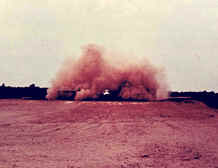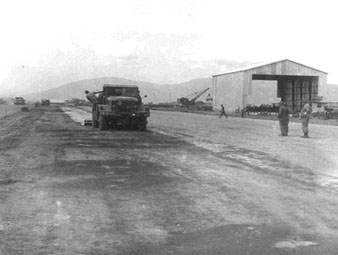The Corps Helped Control Helicopter-Generated Dust during the Vietnam War
|
More than 12,000 helicopters served the U.S. during the Vietnam War. During the early days of the war it was commonly and fallaciously believed that helicopter use would require comparatively little maintenance. It was found, however, that the whirling rotor blades generated huge clouds of dust when the choppers used unimproved areas, unsurfaced hardstands, or hardstands surfaced with pierced steel plank. Dust abrasion wore out rotors in as little as 200 hours and did tremendous damage to carburetors and engines. By obscuring visibility, dust led to crash landings and collisions. In fact, dust put more helicopters out of commission than enemy action.
Upon returning home from a trip to Vietnam in December 1965, General Harold K. Johnson, Army Chief of Staff, expressed serious concern over the problem to Lieutenant General William F. Cassidy, Chief of Engineers, and Lieutenant General W.W. Dick, Jr., Chief of Research and Development. General Cassidy soon came up with a solution. Since World War II, civil works laboratories of the Corps of Engineers had tested hundreds of materials for alleviating dust and stabilizing soil. Among other measures, Cassidy advised applying peneprime, a high penetration, medium-cure, cutback asphalt product as a dust-proofing agent.
In addition, Cassidy suggested the formation of a team of experts from the Office of the Chief of Engineers (OCE), the Waterways Experiment Station, and Army Material Command. The team went to Vietnam for two weeks in February-March of 1966.
After interviewing a number of high-ranking engineers, the team made field inspections in the II and III Corps areas, visiting sites where engineers were constructing roads, airfields, and helicopter landing zones. With information obtained from the engineer commanders, the team made several recommendations for alleviating the dust problem. The report gave first priority to controlling the dust at helicopter landing sites, especially if tactical operations were being planned. It also indicated how much area around a landing site should be dust-proofed and what combinations of asphalt and oils might be used as expedients until sufficient peneprime was available. These recommendations and the use of peneprime eventually settled the dust problem, thereby significantly improving the safety and effectiveness of U.S. helicopter operations.
|
|
 |
Typical dry-season red dust kicked up in Song Be, Vietnam
(Ben Luck) |
 |
| Dramatic demonstration of the dust problem as a U.S. plane takes off in Vietnam |
 |
| As ten Hornet helicopters approached a runway in Bu Dop, a Special Forces Camp in northern III Corps, the rotor wash kicked up a cloud of red dust that blinded this pilot, causing his chopper to crash (Paul Jenkins) |

Engineers apply an asphalt and oil mixture to the fighter apron at Phan Rang Air Base, Vietnam
* * *
August 2002